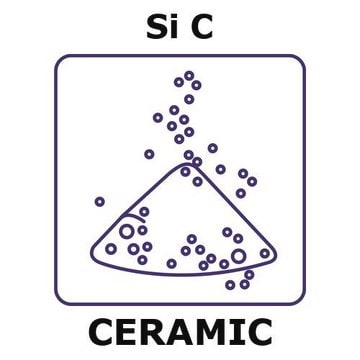Products may be shipped at a different temperature than the recommended long-term storage temperature. If the product quality is sensitive to short-term exposure to conditions other than the recommended long-term storage, it will be shipped on wet or dry-ice. If the product quality is NOT affected by short-term exposure to conditions other than the recommended long-term storage, it will be shipped at ambient temperature. As shipping routes are configured for minimum transit times, shipping at ambient temperature helps control shipping costs for our customers. For more information, please refer to the Storage and Transport Conditions document: https://www.sigmaaldrich.com/deepweb/assets/sigmaaldrich/marketing/global/documents/316/622/storage-transport-conditions-mk.pdf
594911
Silicon carbide
nanopowder, <100 nm particle size
Sinónimos:
Carbon silicide, Carborundum, Methanidylidynesilanylium, Silicon monocarbide
Seleccione un Tamaño
Seleccione un Tamaño
About This Item
Productos recomendados
Formulario
nanopowder
Nivel de calidad
superficie
70-90 m2/g
tamaño de partícula
<100 nm
mp
2700 °C (lit.)
densidad
3.22 g/mL at 25 °C (lit.)
densidad aparente
0.069 g/cm3
cadena SMILES
[C-]#[Si+]
InChI
1S/CSi/c1-2
Clave InChI
HBMJWWWQQXIZIP-UHFFFAOYSA-N
¿Está buscando productos similares? Visita Guía de comparación de productos
Categorías relacionadas
Descripción general
Aplicación
- Overview of silicon carbide power devices: This document provides a comprehensive review of the characteristics and applications of silicon carbide (SiC) in power devices, discussing its advantages over traditional silicon devices in handling high voltages and efficiencies (Choi, 2016).
Forma física
Código de clase de almacenamiento
11 - Combustible Solids
Clase de riesgo para el agua (WGK)
nwg
Punto de inflamabilidad (°F)
Not applicable
Punto de inflamabilidad (°C)
Not applicable
Equipo de protección personal
dust mask type N95 (US), Eyeshields, Gloves
Elija entre una de las versiones más recientes:
¿Ya tiene este producto?
Encuentre la documentación para los productos que ha comprado recientemente en la Biblioteca de documentos.
Los clientes también vieron
Artículos
Composite materials with micron scale reinforcements offer tailored properties for various applications.
Silica's versatility spans various industries, including biomedical applications.
Three approaches generate white light, including LED-based down-conversion for broader applications.
-
How is shipping temperature determined? And how is it related to the product storage temperature?
1 answer-
Helpful?
-
-
How can I determine the shelf life / expiration / retest date of this product?
1 answer-
If this product has an expiration or retest date, it will be shown on the Certificate of Analysis (COA, CofA). If there is no retest or expiration date listed on the product's COA, we do not have suitable stability data to determine a shelf life. For these products, the only date on the COA will be the release date; a retest, expiration, or use-by-date will not be displayed.
For all products, we recommend handling per defined conditions as printed in our product literature and website product descriptions. We recommend that products should be routinely inspected by customers to ensure they perform as expected.
For products without retest or expiration dates, our standard warranty of 1 year from the date of shipment is applicable.
For more information, please refer to the Product Dating Information document: https://www.sigmaaldrich.com/deepweb/assets/sigmaaldrich/marketing/global/documents/449/386/product-dating-information-mk.pdfHelpful?
-
-
Does Silicon carbide, Product 594911, have any surface modification?
1 answer-
According to the supplier, the surface of these silicon carbide nanoparticles are not modified in any way. The material consists solely of silicon and carbon.
Helpful?
-
-
How is Silicon carbide, Product 594911, synthesized?
1 answer-
Conventionally, silicon carbide is prepared using the Acheson process. Specifically, the supplier of these silicon carbide nanoparticles considers the method of manufacturing proprietary.
Helpful?
-
-
How does the storage temperature relate to shipping conditions?
1 answer-
The storage conditions that a Sigma-Aldrich catalog and label recommend for products are deliberately conservative. For many products, long-term storage at low temperatures will increase the time during which they are expected to remain in specification and therefore are labeled accordingly. Where short-term storage, shipping time frame, or exposure to conditions other than those recommended for long-term storage will not affect product quality, Sigma-Aldrich will ship at ambient temperature. The products sensitive to short-term exposure to conditions other than their recommended long-term storage are shipped on wet or dry ice. Ambient temperature shipping helps to control shipping costs for our customers. At any time, our customers can request wet- or dry-ice shipment, but the special handling is at customer expense if our product history indicates that the product is stable for regular shipment.
Helpful?
-
-
What is the Department of Transportation shipping information for this product?
1 answer-
Transportation information can be found in Section 14 of the product's (M)SDS.To access the shipping information for this material, use the link on the product detail page for the product.
Helpful?
-
-
I am interested in other types of nanoparticles. What does Sigma-Aldrich offer for my application?
1 answer-
Sigma-Aldrich offers a variety of nanoparticles (both as powders and as dispersions), organized in the Online Product Catalog by element.
Helpful?
-
Active Filters
Nuestro equipo de científicos tiene experiencia en todas las áreas de investigación: Ciencias de la vida, Ciencia de los materiales, Síntesis química, Cromatografía, Analítica y muchas otras.
Póngase en contacto con el Servicio técnico



